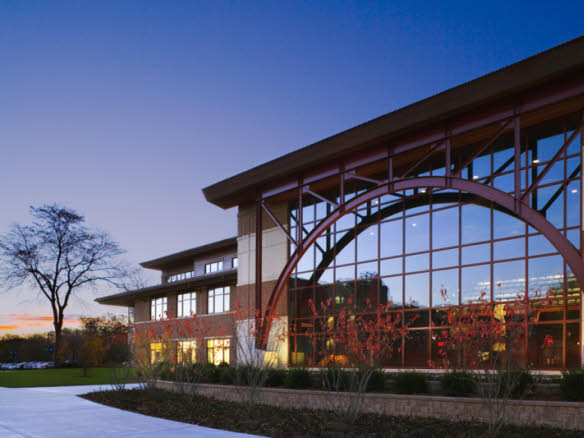Aurora University's Institute for Collaboration
6/11/2009

The new Institute for Collaboration is an innovative, collaborative "real world" learning laboratory that incorporates tutoring, community service, and professional certification. Built on the south edge of campus, it complements existing "Richardsonian Romanesque" campus architecture while comfortably integrating contemporary building technologies. This 68,000 square foot building includes 29 dedicated classrooms; more than 60 office spaces and resource rooms; the 500-seat Crimi Auditorium; and the 'Cyber-Lab' donated by The Caterpillar Corporation which hosts the "Communities In Schools" program.
The Institute for Collaboration reflects the goals of the No Child Left Behind Act. It focuses on achievements of all students. It is a teaching / learning laboratory where student teachers and faculty work directly with elementary school children on campus. "It's an opportunity for us to take the theoretical work of teaching and apply it with real life kids out of Aurora's neighborhoods," said Gary Jewel, College of Education Dean.
This unique "school within a university" educational model integrates 200 fourth and fifth graders (8 classroom sections) in a total immersion program with Aurora University students; practicing K-12 teachers (graduate and doctoral students); human service professionals; community youth; wellness and educational agencies; and the general resources of Aurora University.
The 500 seat multipurpose Concert Hall is centrally located on the campus. This positions it as the main hall for university events as well as public functions. Acoustically designed as a Concert Hall, it is also used as an Auditorium for lectures and special events. The fully glazed end wall behind the proscenium provides views of the campus from the main hall. The acoustics of the concert hall are designed so they can be regulated, and can be altered to modify its acoustical brightness. Special perimeter treatment in the hall was chosen for its acoustic mass and bass reflectivity.
The Institute for Collaboration received a 2008 "Outstanding Design" award from American School and University.
Read more on the Institute for Collaboration here.